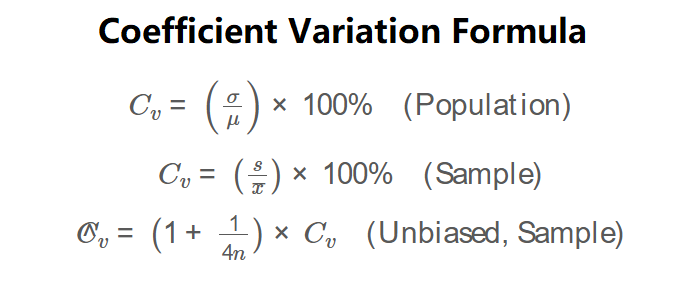 Home
Home
 Back
Back

Definition: The Coefficient of Variation Calculator computes the coefficient of variation (Cᵥ), a standardized measure of dispersion, expressed as a percentage. For sample data, it also calculates the unbiased coefficient of variation (Ĉᵥ) to adjust for small sample sizes.
Purpose: This tool is used to compare the relative variability of datasets with different units or means, widely applied in statistics, finance, and quality control to assess consistency or risk.
The calculator uses the following formulas:
\( C_v = \left( \frac{\sigma}{\mu} \right) \times 100\% \quad \text{(Population)} \)
\( C_v = \left( \frac{s}{\bar{x}} \right) \times 100\% \quad \text{(Sample)} \)
\( \hat{C}_v = \left( 1 + \frac{1}{4n} \right) \times C_v \quad \text{(Unbiased, Sample)} \)
Where:
Steps:
The coefficient of variation is essential for:
Example: Calculate the coefficient of variation for a sample dataset with a mean of 50, standard deviation of 10, and sample size of 16.
Q: What is the coefficient of variation?
A: It’s a measure of relative variability, expressed as a percentage, calculated as the standard deviation divided by the mean.
Q: Why calculate the unbiased coefficient for samples?
A: The unbiased Ĉᵥ adjusts for bias in small samples, providing a more accurate estimate of the population’s coefficient of variation.
Q: When is the coefficient of variation useful?
A: It’s useful for comparing the relative spread of datasets with different units or means, such as assessing risk or consistency in diverse contexts.